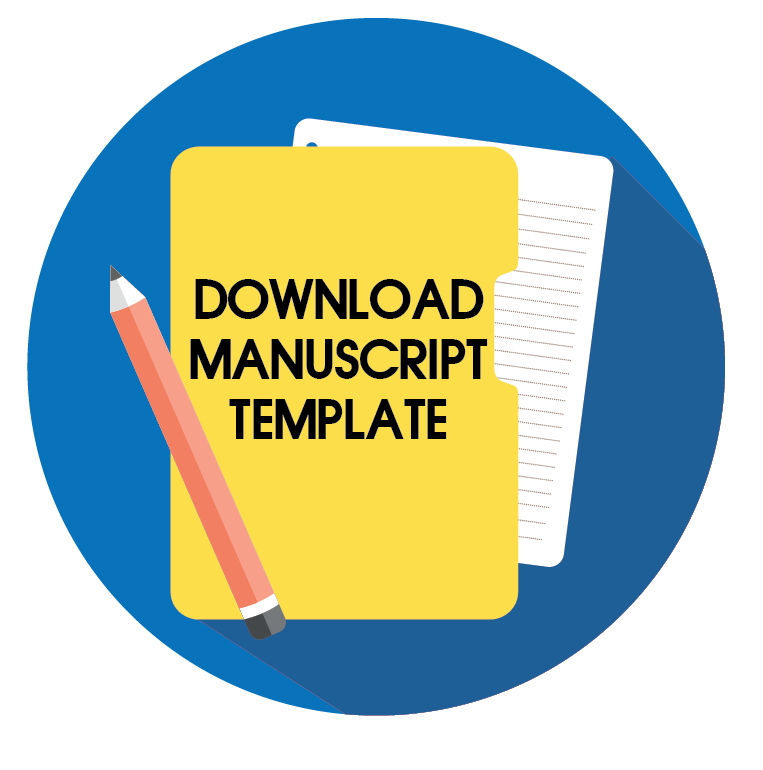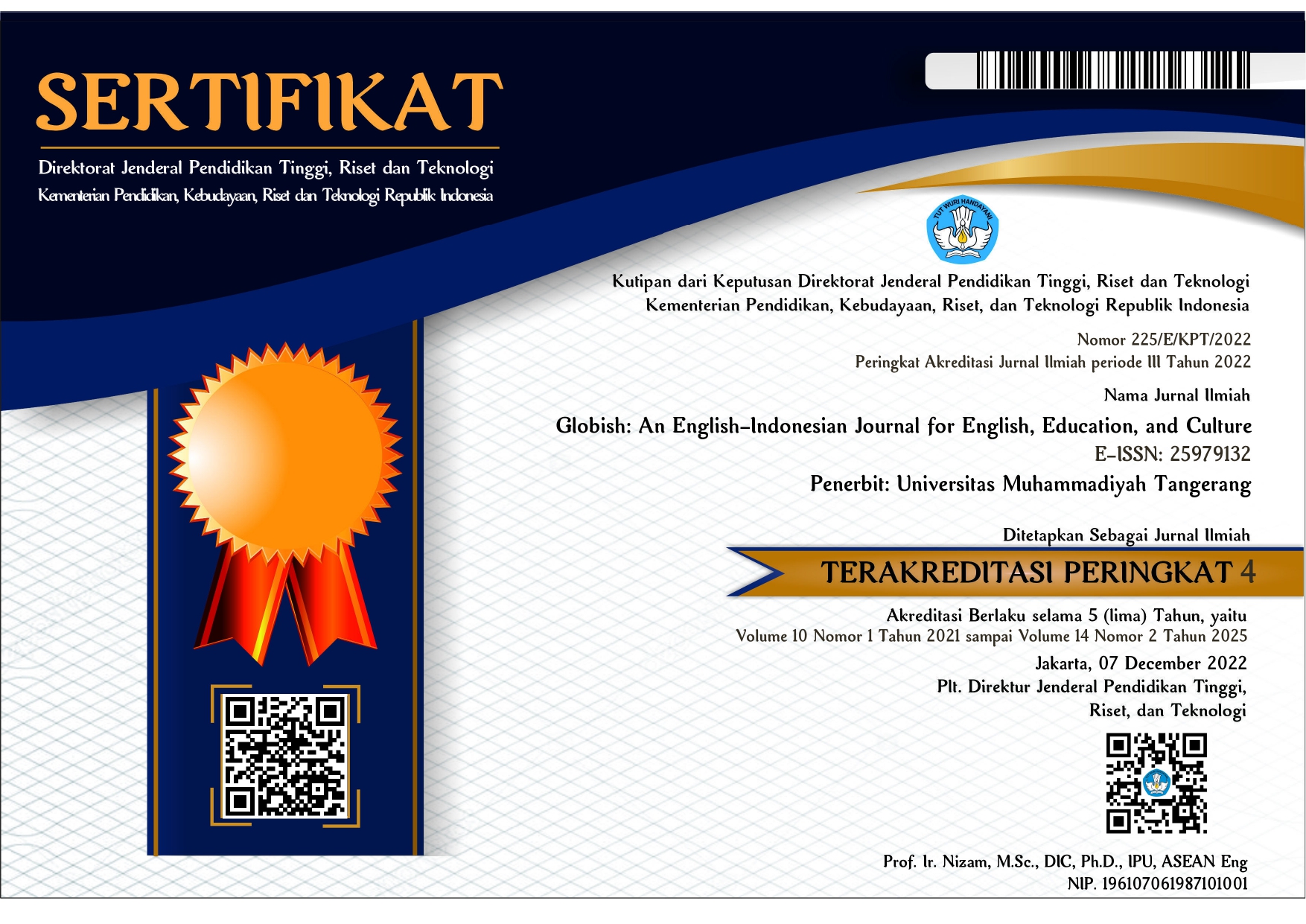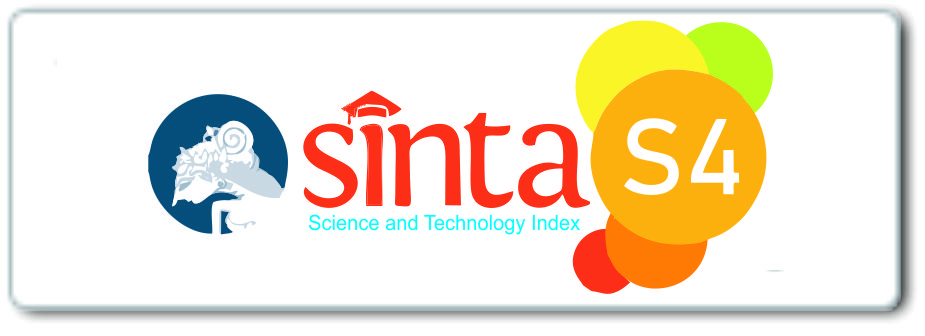The Effectiveness of Infographics to Enhance Students' Vocabulary Mastery at Eighth Grade Students of SMPN 1 Kota Tangerang Selatan
Abstract
This research aimed to determine if using infographics in the eighth grade at SMPN 1 Kota Tangerang Selatan had a significant effect on students' vocabulary mastery. This study employed a quantitative approach and a quasi-experimental design. A total of 78 students participated in the study; 39 from each of the two classes (the experimental and control) were included in the sample. Each class took a pre-and post-test during the first and last meetings. Independent sample t-tests were run in SPSS version 22 to evaluate the hypothesis. The results showed that using infographics enhanced the vocabulary mastery of eighth-graders at SMPN 1 Kota Tangerang Selatan. The effect size was 0.80, with a significance level of 0.001 for the two-tailed Independent T-test (0.001 < 0.05). That supports the moderate size effect and indicates the acceptance of the alternative hypothesis. Thus, using an infographic as a teaching tool provides a significant effect on students' vocabulary mastery.
Keywords
Full Text:
PDFReferences
Aldalalah, O. M. A. (2020). The Effectiveness of Infographic via Interactive Smart Board on Enhancing Creative Thinking: A Cognitive Load Perspective. International Journal of Instruction, 14(1), 345–364. https://doi.org/10.29333/iji.2021.14120a
Alqudah, D., Bin Bidin, A., & Bin Md Hussin, M. A. H. (2019). The Impact of Educational Infographic on Students’ Interaction and Perception in Jordanian Higher Education: Experimental Study. International Journal of Instruction, 12(4), 669–688. https://doi.org/10.29333/iji.2019.12443a
Alyahya, D. (2019). Infographics as a Learning Tool in Higher Education : The Design Process and Perception of an Instructional Designer. International Journal of Learning, Teaching and Educational Research, 18(1), 1–15. https://doi.org/https://doi.org/10.26803/ijlter.18.1.1
Apoko, T. W., Putri, S. W., Inayah, T. M., & Maharani, S. F. (2024). Students’ Motivation in Reading English Recount Texts in Junior High School. Globish: An English-Indonesian Journal for English, Education, and Culture, 13(1), 35. https://doi.org/10.31000/globish.v13i1.9667
Ardiyanti S, S., Kamsinah, K., Nurasik, N., & Said, A. M. (2021). The Difficulties in Teaching Vocabulary Faced by The English Teachers at Mts Madani Pao-Pao Makassar. English Language Teaching for EFL Learners, 3(2), 54. https://doi.org/10.24252/elties.v3i2.18851
Arikunto, S. (2010). Prosedur Penelitian Pendidikan. Rineka Cipta. https://irigasi.info/wp-content/uploads/2021/03/PROSEDUR-PENELITIAN-17-Mar-2021-14-11-12.pdf
Castillo-Cuesta, L., & Quinonez-Beltran, A. (2022). Using Digital Comics for Enhancing EFL Vocabulary Learning during the COVID-19 Pandemic. International Journal of Learning, Teaching and Educational Research, 21(5), 478–491. https://doi.org/10.26803/ijlter.21.5.24
Cohen, L., Manion, L., & Morrison, K. (2018). Research Method in Education (8th Ed). Routledge. https://ds.amu.edu.et/xmlui/bitstream/handle/123456789/2490/Research-Methods-in-Education-sixth-edition.pdf?sequence=1&isAllowed=y
Dewantari, F., Utami, I. G. A. L. P., & Santosa, M. H. (2021). Infographics and Independent Learning for English Learning in the Secondary Level Context. Journal on English as a Foreign Language, 11(2), 250–274. https://doi.org/10.23971/jefl.v11i2.2784
Eremkina, N. I., Babushkina, L. E., Porchesku, G. V., Rublеva, O. S., & Nikulina, E. G. (2022). Influence of digital infographics services on mnemonics’ effectiveness when teaching foreign language vocabulary. Perspektivy Nauki I Obrazovania, 55(1), 236–251. https://doi.org/10.32744/pse.2022.1.15
Evenddy, S. S. et al. (2023). Promoting Motivation in Writing ELT Through Infographics. Journal of Linguistics, Literacy, and Pedagogy Available, 2(1), 11–20. https://jurnal.untirta.ac.id/index.php/JLLP/article/view/20032
Fitria, T. N. (2024). Choosing Objective and Non-objective Test as Instrument for Assessment of EFL Student Learning Outcomes. Globish: An English-Indonesian Journal for English, Education, and Culture, 13(1), 1. https://doi.org/10.31000/globish.v13i1.9601
Fitriani, A., Melani, M., & Lismay, L. (2021). The Effect of Using Infographics on Students' Writing Summary Skill. Journal of English Language and Education, 6(1), 111–121. https://doi.org/10.31004/jele.v6i1.108
Hekmatiar, Y., & Umam, C. (2020). The Effects of Learning Media and Vocabulary Mastery towards Reading English Text Skill. Journal of English Language Teaching and Literature (JELTL), 3(1), 33–40. https://ejournal.lppm-unbaja.ac.id/index.php/jeltl/article/view/784
Juniardi, Y., Herlina, L., Lubis, A. H., Irmawanty, & Pahamzah, J. (2020). Computer-vs. Mobile-assisted Learning to Promote EFL Students' Speaking Skills: A Preliminary Classroom-based Research. International Journal of Instruction, 13(3), 417–432. https://doi.org/10.29333/iji.2020.13329a
Kamal, A., & Faraj, A. (2015). Effective Strategies for Turning Receptive Vocabulary into Productive Vocabulary in EFL Context. Journal of Education and Practice, 6(27), 10–20. https://files.eric.ed.gov/fulltext/EJ1077387.pdf
Lailan, E., Lubis, S., & Solin, M. (2018). The Development of Standard Vocabulary Mastery Based on Storybooks. Annual International Seminar on Transformative Education and Educational Leadership (AISTEEL), 200(3), 363–367. https://doi:10.2991/aisteel-18.2018.79
Lankow, J. (2012). Infographics: The Power of Visual Storytelling. John Wiley & Sons, Inc. https://adams.marmot.org/Record/.b37883860
Leavy, P. (2017). Research Design: Qualitative, Quantitative, Mixed Methods, Arts-Based, and Community-Based Participatory Research Approach. The Guilford Press. https://lms.su.edu.pk/download?filename=1606884489-research-design-quantitative-qualitative-mixed-methods-arts-based-and-community-based-participatory-research-approaches-pdfdrive.pdf&lesson=40744
Linse, T. C. (2005). Practical English Language Teaching: Young Learners (International ed.). McGraw-Hill Companies. https://books.google.co.id/books/about/Practical_English_Language_Teaching.html?id=d2wvAAAACAAJ&redir_esc=y
Maamuujav, U., Krishnan, J., & Collins, P. (2020). The Utility of Infographics in L2 Writing Classes: A Practical Strategy to Scaffold Writing Development. TESOL Journal, 11(2). https://doi.org/10.1002/tesj.484
Miranty, D., Widiati, U., Cahyono, B. Y., Intan, T., & Tengku, S. (2023). Automated Writing Evaluation Tools for Indonesian Undergraduate English as a Foreign Language Students’ Writing. 12(3), 1705–1715. https://doi.org/10.11591/ijere.v12i3.24958
Munadi, Y. (2013). Media Pembelajaran. Gaung Persada Press. https://ecampus-fip.umj.ac.id/pustaka_umj/main/item/11257
Nunan, D. (2003). Practical English Language Teaching (First edition). McGraw-Hill Companies. https://books.google.co.id/books/about/Practical_English_Language_Teaching
Okyar, H., & Çakır, A. (2019). Effects of different reading texts on vocabulary gain, use, and retention. Journal of Language and Linguistic Studies, 15(1), 111–122. https://doi.org/10.17263/jlls.547634
Pahamzah, J., Syafrizal, S., & Nurbaeti, N. (2022). The Effects of EFL Course Enriched with Kahoot on Students’ Vocabulary Mastery and Reading Comprehension Skills. Journal of Language and Linguistic Studies, 18(1), 643–652. https://doi.org/https://doi.org/ 10.52462/jlls.209
Puspitarini, Y. D., & Hanif, M. (2019). Using Learning Media to Increase Learning Motivation in Elementary School. Anatolian Journal of Education, 4(2), 53–60. https://doi.org/10.29333/aje.2019.426a
Rohmatillah. (2014). A Study on Students’ Difficulties in Learning Vocabulary. Jurnal Tadris Bahasa Inggris IAIN Raden Intan, 6(1), 75–93. https://doi:org/10.24042/ee-jtbi.v6i1.520
Saptodewo, F. (2014). Design Infografis Sebagai Penyajian Data Menarik. Journal Design, 1(3), 194. https://journal.lppmunindra.ac.id/index.php/Jurnal_Desain/article/view/563
Sartika, R. (2017). Implementing Word Wall Strategy in Teaching Writing Descriptive Text for Junior High School Students. Journal of English and Education, 5(2), 179-186. https://ejournal.upi.edu/index.php/L-E/article/view/9948
Siricharoen, W. V. (2014). Infographics : The New Communication Tools in Digital Age. Procedia – Social and Behavioral Sciences. https://www.researchgate.net/publication/256504128_Infographics_The_New_Communication_Tools_in_Digital_Age
Smiciklas, M. (2012). The Power of Infographics. Que Publishing. https://www.pdfdrive.com/the-power-of-infographics-using-pictures-to-communicate-and-connect-with-your-audiences-e156936039.html
Syafrizal, S., Muhajir, M., Pahamzah, J., & Furqon, F. (2021). The Effects of Using Whiteboard Animation toward Indonesian Students’ Vocabulary and Grammar Mastery. Journal of Language and Linguistic Studies, 17(2), 783–793. https://doi.org/10.52462/jlls.55
Teng, F. (2016). The Effects of Word Exposure Frequency on Incidental Learning of the Depth of Vocabulary Knowledge. GEMA Online Journal of Language Studies, 16(3), 53–70. https://doi.org/10.17576/gema-2016-1603-04
Ungu, N. K., & Qathrunnada, Z. (2024). The Effectiveness of Picture Word Inductive Model on Writing Ability in Narrative Text at Tenth Graders of MAN 1 Wonosobo. Globish: An English-Indonesian Journal for English, Education, and Culture, 13(1), 44. https://doi.org/10.31000/globish.v13i1.9908
Wirawan, F. (2020). A Study on The Teaching Media Used by The English Teacher at SMP Muhammadiyah 2 Malang. Jurnal Ilmiah Profesi Pendidikan, 5(2), 89–95. https://doi.org/10.29303/jipp.v5i2.115
Yıldırım, S., et al. (2016). A study on the Development of an Infographic Designer Questionnaire and Designer Opinions. EDP Sciences, 3, 1010. https://doi.org/10.1051/shsconf/20163101010
DOI: http://dx.doi.org/10.31000/globish.v13i2.11259
Article Metrics
Abstract - 1233 PDF - 732Refbacks
- There are currently no refbacks.
Globish
Program Studi Pendidikan Bahasa Inggris
Fakultas Keguruan dan Ilmu Pendidikan
Universitas Muhammadiyah Tangerang
Jl. Perintis Kemerdekaan I/33, Cikokol
Kota Tangerang, Indonesia
e-mail: globish_journal@umt.ac.id
Globish (p-ISSN: 2301-9913 | e-ISSN: 2301-9913) is licensed under a Creative Commons Attribution-ShareAlike 4.0 International License.









